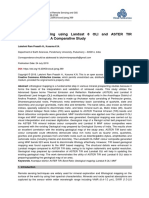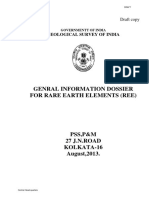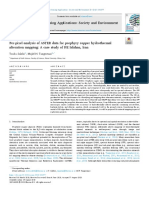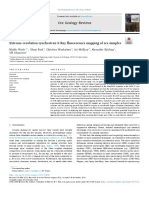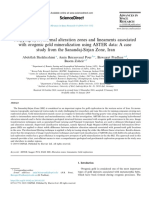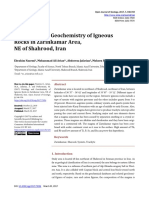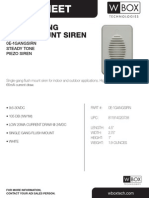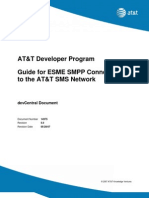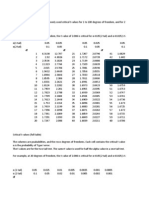Professional Documents
Culture Documents
Geochemical Exploration New Solution To An Old Problem Identification of Gold Mineralized Zones
Original Title
Copyright
Available Formats
Share this document
Did you find this document useful?
Is this content inappropriate?
Report this DocumentCopyright:
Available Formats
Geochemical Exploration New Solution To An Old Problem Identification of Gold Mineralized Zones
Copyright:
Available Formats
Volume 7, Issue 11, November – 2022 International Journal of Innovative Science and Research Technology
ISSN No:-2456-2165
Geochemical Exploration New Solution to an Old
Problem: Identification of Gold Mineralized Zones
Vishnu Kumar Singh*
Geological Survey of India, State Unit: Andhra Pradesh, SR, Hyderabad – 500068
* Corresponding Author
Abstract:- Veins and pegmatite are suitable carriers for II. GEOLOGY OF THE STUDY AREA
the mineralization of several elements such as Au(gold),
Silver(Ag), Cu( copper) etc. in this paper we will discuss The area is occupied by the rocks of Khondalite,
the REE and Gold mineralization in the korukonda area Charnockite and Migmatites Groups of Eastern Ghats
nearby to Rajahmundry, Andhra Pradesh. Here pegmatite Supergroup in the north, overlain by Tirupathi Formation of
was the rich source of REE, Graphite and quartz vein East Coast / Gondwana of Gondwana Supergroup, Deccan
intruded within the Migmatite gneiss could be a potential Trap, Rajahmundry Sandstone towards southern part and
source of Au(Gold). The values of Rare Earth Elements Krishna-Godavari Formation towards southwest The
(REE) from Lanthanum (La) to Lutetium (Lu) are Khondalite Group is represented by khondalite, which occupies
exclusively higher concentration in the eastern and North- the northern part of the area. Khondalite is observed around
eastern parts of the area, The value of LREE Ranges Mellisala, Gopalpuram and Tirumalayyapalem. It is chiefly of
from143.25 ppm to 2042.75 ppm, and HREE ranges from garnet-sillimanite + graphite gneiss and contains a few thin
9.09 to 27.37 ppm. the maximum value of Au(gold) impersistent bands of quartzite at places. Intermediate
observed is around 47 ppb in stream sediments which charnockite and hypersthene granite/acid charnockite
indicates moderate enrichment of Au (Gold) in the study comprising the charnockite Group occur as minor bodies. The
area . Migmatite Group is made up of garnetiferous quartzo
feldspathic gneiss and manganiferous quartzo-feldspathic
Keywords:- REE (Rare Earth Elements ), Rajahmundry, rocks which are derived from the former due influx of quartzo
Migmatite , Veins, Pegmatite,Ppm(Parts Per Million), feldspathic injections and observed near Rajavaram, korukonda
Ppb(Parts Per Billion) and Srirangapatam.
I. INTRODUCTION
The area is bounded by latitude N 17° 00’ 00” to 17° 15’
00” and longitude 81° 45’ 00” to 82° 00’ 00” E. covers the
upland area North of Godavari delta in East Godavari District
of Andhra Pradesh. It is well connected by a metalled road. The
higher values of LREE are recorded over pegmatites intruded
within Manganiferous (Migmatite) gneiss, at the contact of
Basalt & Tirupathi Sandstone and garnet-sillimanite gneiss in
the area. It varies from 143.25 ppm to 2042.75 ppm with
median values of 643.26 ppm. The threshold values for LREE
is 1195.39, whereas HREE is varies from 9.09 ppm to 27.37
ppm with median values of 16.87 ppm. The threshold values
for HREEs is 23.08. The elevated values obtained might be due
to the weathering and leaching of Pegmatite and gneisses in the
area. The higher concentrations of REE suggesting that
gneisses and Pegmatite are the source rocks for REE. It is
observed that LREE content is comparatively more than the
HREE. Gold(Au), Tellurium (Te), selenium(Se) ,Bi(Bismuth), Fig 1: Geological Map of Study Area ( Source :
Antimony(Sb) and Silver show moderate level of enrichment, Geological survey of India )
which indicates that gold and silver might be available in the
pegmatite and quartz vein in form of selenides and tellurides
IJISRT22NOV845 www.ijisrt.com 735
Volume 7, Issue 11, November – 2022 International Journal of Innovative Science and Research Technology
ISSN No:-2456-2165
III. MATERIAL & METHOD assigning weights. The advantage of IDW-generated
interpolated raster surface in exactly restricted to lowest &
194 Soil samples were collected as per the NGCM highest values, but statistically generated kriging surface is
program of the Geological survey of India field season 2018- restricted to the values which are above the available lowest
19 , Chemical Analysis of the Sample was done by the values and much below the actual highest values. Therefore,
Chemical Division, Southern Region Hyderabad anomaly zone/threshold values generated by box plot
500068.Spatial Analytical techniques were used to prepare the sometime do not fall within the limit of Krigging surface
geochemical distribution of elements of elements and the
environment for Spatial and statistical Analysis was GIS
IV. RESULT & DISCUSSION
A. Statistical Methods
Gold (Au), Bismuth(Bi) and Antimony (Sb): values of
Univariate Statistical Analysis gold .bismuth and Antimony are quite encouraging in the
The univariate analysis explores each variable in a data chemical result of stream sediment highest value of gold
set, separately. It looks at the range of values, as well as the observed nearby kolavacherla and thima puram which is
central tendency of the values. It describes the pattern of around 0.05 ppm due to sieving process by 120 mesh sieve .
response to the variable. It describes each variable on its own. the value of gold diminished. the higher value of gold observed
Univariate analysis commonly involves reporting measures of over the pegmatite and quartz veins of migmatite gneiss group
central tendency. This involves describing the way in which of eastern ghat super group and at the contact of Deccan basalt
quantitative data tend to cluster around some value. In and Tirupathi sandstone. Same way the value of Bi and Sb
univariate analysis, the measure of central tendency is an anomalous values fall around the kolavacherla and its
average of a set of measurements, the word "average" is surrounding which indicate that the area around the
variously construed as (arithmetic) mean, median, mode, or kolavacherla and its surrounding have the potential for gold
another measure of location. The descriptive statistics function mineralization
of MS Excel was used to find the univariate statistic containing
the number of samples or count (n), minimum value, Silver (Ag): silver values of stream sediments and slope
maximum value, mean, median, mode, standard deviation, and wash shows moderate enrichment in the area since the samples
skewness. The mean, median, and mode values are compared were sieved by the 120 mesh size sieve the values got
to have a theoretical assessment of the normality in the diminished. The highest value of Ag observed was 0.17 ppm
distribution of elements. In case, skewness was found to be which shows around 3 times Enriched then the continental
high, histograms were prepared for those elements, using crust over the quartz and pegmatite veins of Migmatite group
geostatistical values of rocks and laterite of Rajahmundry sandstone
Bi-variant Statistics Rare Earth Element (REE)
The bivariate analysis involves the analysis of two
variables (often denoted as X, Y), for the purpose of LREE: The higher values of LREE are observed over
determining the empirical relationship between them. In order Manganiferous gneiss and garnet sillimanite gneiss in the area.
to see if the variables are related to one another, it is common It varies from minimum value 143 ppm to maximum value is
to measure how those two variables simultaneously change 2042 ppm with median values of 643.26 The threshold values
together. Common forms of bivariate analysis involve creating for LREE is 1195.39 ppm. The elevated values obtained might
a percentage table or a scatter plot graph and computing a be due to the weathering and leaching of Pegmatite and
simple correlation coefficient. The correlation matrix is gneisses in the area. The higher concentrations of REE over
prepared by using the correlation function of MS Excel lithology suggesting that gneisses and Pegmatite are the source
rocks for REE, which is evident from the analytical results and
The software used for the analysis is MS-EXCEL and elemental distribution maps
Arc GIS. The statistical table for each element is attached with
their respective elemental distribution maps. The term
univariate statistics is commonly used in statistics to HRRE: HREE varies from minimum value 9.09 ppm to
distinguish a distribution of one variable from a distribution of maximum value is 23.37 ppm with median values of 16.87
several variables. Univariate analysis is commonly used in the ppm The threshold values for HREE is 23.08 ppm it was
first stage of analysis of the data at hand, which include observed that LREE content is comparatively more than the
descriptive statistics, histogram, and box plot. HREE content which may be due to low concentration of high
field strength elements (HFSE) in Pegmatite and gneisses
Inverse Distance Weighting (IDW) present in the area.
It is a type of deterministic method for multivariate
interpolation with a known scattered set of points. The
assigned values to unknown points are calculated with a
weighted average of the values available at the known points.
The name given to this type of methods was motivated by the
weighted average applied, since it resorts to the inverse of the
distance to each known point ("amount of proximity") when
IJISRT22NOV845 www.ijisrt.com 736
Volume 7, Issue 11, November – 2022 International Journal of Innovative Science and Research Technology
ISSN No:-2456-2165
Table 1: Correlation matrix of Bi-Au-Sb-Hg elements
Hg(ppb) Au (ppb) Sb(ppb) Bi(ppm)
Hg(ppb) 1
Au (ppb) 0.00618 1
Sb(ppb) -0.006 0.144795 1
Bi(ppm) 0.008358 0.162949 0.871686 1
Table 2: Descriptive statistics of LREE and HREE
Parameters LREE HREE
Mean 685.83 16.86
Standard Error 26.09 0.22
Median 643.26 16.87
Standard Deviation 363.46 3.11
Sample Variance 132103.86 9.69
Kurtosis 0.45 0.83
Skewness 0.72 0.25
Range 1899.51 18.29
Minimum 143.25 9.09
Maximum 2042.75 27.37 Fig 2: Geochemical map of Heavy Rare Earth Elements
Mean+2sd 1412.76 23.08 (HREE) over the Lithology map of the study area
Table 3: Correlation matrix of LREEs & HREEs lanthanide series
LREE La Ce Pr Nd Eu Sm Gd
La 1.00
Ce 1.00 1.00
Pr 0.99 0.99 1.00
Nd 0.98 0.99 0.99 1.00
Eu 0.72 0.71 0.68 0.69 1.00
Sm 0.99 0.99 0.99 0.98 0.72 1.00
Gd 0.98 0.97 0.97 0.96 0.72 0.99 1.00
HREE Tb Dy Ho Er Tm Yb Lu
Tb 1.00
Dy 0.74 1.00
Ho 0.30 0.85 1.00
Er 0.42 0.84 0.92 1.00
Tm -0.01 0.57 0.86 0.89 1.00
Yb 0.01 0.55 0.83 0.88 0.99 1.00
Lu -0.06 0.48 0.79 0.81 0.95 0.98 1.00
Very strong Correlation
Strong Correlation
IJISRT22NOV845 www.ijisrt.com 737
Volume 7, Issue 11, November – 2022 International Journal of Innovative Science and Research Technology
ISSN No:-2456-2165
Fig 3: Geochemical map of Light Rare Earth Elements Fig 6: Geochemical map of Gold (Au) over the Lithology
(LREE) over the Lithology map of the study area map of the study area
Fig 4: Geochemical map of Cerium (Ce) over the Lithology
Fig 7: Geochemical map of Silver (Ag) over the Lithology
map of the study area
map of the study area.
Fig 5: Geochemical map of Lanthanum (La) over the Fig 8: Anomalous zones of Au(gold), Se(selenium) and Te
Lithology map of the study area (tellurium) over the Lithology map of the study area
IJISRT22NOV845 www.ijisrt.com 738
Volume 7, Issue 11, November – 2022 International Journal of Innovative Science and Research Technology
ISSN No:-2456-2165
V. CONCLUSION [12]. Craw, D. (2001). Tectonic controls on gold deposits and
their environmental impact, New Zealand. Journal of
By the use of statistical methods and spatial analysis Geochemical Exploration, 73(1), 43–56
techniques of GIS several inferences were made regarding the [13]. Grunsky, E. C. (2010). The interpretation of geochemical
elemental enrichment in the study area. anomalous zone of survey data. Geochemistry: Exploration, Environment,
gold(Au) found over the migmatite group of rocks which were Analysis, 10, 27–74
profusely intruded by the pegmatites and quartz veins. values [14]. Harris, J. R., Wilkinson, L., & Grunsky, E. C. (2000).
of selenium are also very high in the soil samples this also Effective use and interpretation of lithogeochemical data
indicate that gold might be present in the quartz veins as in regional mineral exploration programs; application of
selenides or tellurides geographic information systems (GIS) technology. Ore
Geology Reviews, 16, 107–143.
REFERENCES [15]. Johnson, D. E. (1998). Applied Multivariate Methods for
Data Analysis. California: Duxbury Press, Pacific Grove
[1]. Anil M Pophare,2014, Revisit to Graphite- Tungsten [16]. Xu, Y., & Cheng, Q. (2001). A fractal filtering technique
Deposits of East Godavari Districts,Andhra Pradesh, for,prospecting regional geochemical maps for mineral
Journal of Geological Society of India, exploration. Geochemistry: Exploration, Environment,
DOI:10.1007/s12594-014-0147-6. Analysis, 1, 147–156
[2]. Duddy, L.R., 1980, Redistribution and Fractionation of [17]. LEVINSON, A.A. 1974. Introduction to Exploration
Rare- Earth and Other Elements in A Weathering Profile: Geochemistry. Applied Publishing Ltd., Wilmette,
Geochemical Geology, v. 30, no. 4, p. 363-381 [18]. S.K. Biswas et al. Geological domain for gold
[3]. Krishnaswamy, S., 1951, Progress Report of Geological exploration in India: abstract
Survey of India for the field-season 1950-51, “A Brief [19]. D. Chardon et al. Precambrian continental strain and
Report On A Survey of Chodavaram and Polavaram shear zone patterns: South Indian case J. Geophys.
Taluks, East and West Godavari Districts”.. Res.(2008)
[4]. I Konrad B. Krauskopf and Dennis K. Bird, (1995). [20]. Ajit Kumar Sahoo etal , Genetic aspects of gold
Introduction to Geochemistry, McGraw-Hill, third mineralization in the Southern Granulite Terrain, India,
edition.. ore geology rev. 2016,pg 1243-1262
[5]. Standard Operating Procedure (Revised) for National
Geochemical Mapping, Geological survey of India.
[6]. Ali, K., Cheng, Q., Wenchang, L., & Yongqing, C.
(2006).Multi-element association analysis of stream
sediment geocgeochemistry data predicting gold deposits
in south-central Yunnan Province, China. Geochemistry:
Exploration, Environment, Analysis, 6, 341–348
[7]. Benjamin, O. O., Che, V. B., Fon, A. N., Embui, V. F.,
& Suh, C. E. (2014). Regional Geochemical Stream
Surveyfor Gold Exploration in the Upper Lom Basin,
Eastern Cameroon. International Journal of Geosciences
[8]. Boyle, R. W. (1979). The geochemistry of gold and its
deposits. Bulletin Geological Survey Canada, 280, 1–584
[9]. Carranza, E. J. M. (2009). Mapping of anomalies in
continuous and discrete fields of Stream sediment
geochemical landscapes. Geochemistry: Exploration,
Environment, Analysis, 10(2), 171–187,
[10]. Chandrajith, R., Dissanayake, C. B., & Tobschall, J.
(2001). Application of multi-element relationships in
stream sediments to mineral exploration; a case study of
Walawe Ganga Basin, Sri Lanka. Applied Geochemistry,
16(3), 339–350.
[11]. Fletcher, W. K. (1990). Dispersion and behavior of gold
in stream sediments, A contribution to the Canada/British
Columbia Mineral Development Agreement. Open file,
1990.
IJISRT22NOV845 www.ijisrt.com 739
You might also like
- Discovering of High Potential Zones For Gold MinerDocument7 pagesDiscovering of High Potential Zones For Gold MinerWisnu astamanNo ratings yet
- Mapeamento Geológico Usando Imagens ASTER e LandsatDocument18 pagesMapeamento Geológico Usando Imagens ASTER e LandsatAderito OfumaneNo ratings yet
- Sro 1669 1967 1968 Report 1 (Primary) (Dcport1gsigovi030242 Revision-1)Document14 pagesSro 1669 1967 1968 Report 1 (Primary) (Dcport1gsigovi030242 Revision-1)Rajashekar reddyNo ratings yet
- Current Science 2006 995Document7 pagesCurrent Science 2006 995antony2288No ratings yet
- ASTER Mapping Gold Alteration MineralsDocument37 pagesASTER Mapping Gold Alteration MineralsJULIO JEAN CONDEZO AGUILARNo ratings yet
- Role of Remote Sensing and GIS To Provide Geological Input For Hydrocarbon Exploration - A Case Study On Godavari Basin RajahmundryDocument5 pagesRole of Remote Sensing and GIS To Provide Geological Input For Hydrocarbon Exploration - A Case Study On Godavari Basin RajahmundryViikas PathaniaNo ratings yet
- Examining Fingerprint Trace Elements in CassiteriteDocument13 pagesExamining Fingerprint Trace Elements in CassiteriteMuhammad ArifinNo ratings yet
- Target Diamond Dr.S.Ravi PDFDocument154 pagesTarget Diamond Dr.S.Ravi PDFshivam tiwariNo ratings yet
- GSI Draft Report on Rare Earth ElementsDocument34 pagesGSI Draft Report on Rare Earth ElementsAgnidipto BasuNo ratings yet
- Sale Hi 2020Document15 pagesSale Hi 2020JulioJCondezoNo ratings yet
- 04.chemostratigraphy of The Permian Sediments in Bintuni Area, Papua Barat ProvinceDocument17 pages04.chemostratigraphy of The Permian Sediments in Bintuni Area, Papua Barat ProvinceHerry SuhartomoNo ratings yet
- Role of Remote Sensing and GIS To Provide Geological Input For Hydrocarbon Exploration - A Case Study On Godavari Basin RajahmundryDocument5 pagesRole of Remote Sensing and GIS To Provide Geological Input For Hydrocarbon Exploration - A Case Study On Godavari Basin RajahmundrySu MoNo ratings yet
- ch30Document11 pagesch30Dirceu NascimentoNo ratings yet
- JADM Volume 6 Issue 1 Pages 121-132Document13 pagesJADM Volume 6 Issue 1 Pages 121-132reza khNo ratings yet
- Full PaperDocument16 pagesFull PaperJavier RojasNo ratings yet
- Beowulf Mining PLC: ("Beowulf" or The "Company")Document5 pagesBeowulf Mining PLC: ("Beowulf" or The "Company")Nurten DevaNo ratings yet
- Emegeo 10Document6 pagesEmegeo 10Srikanth Jutru100% (1)
- Compositional Characteristics of Mineralised and Unmineralised Gneisses and Schist Around The Abansuoso Area, Southwestern GhanaDocument17 pagesCompositional Characteristics of Mineralised and Unmineralised Gneisses and Schist Around The Abansuoso Area, Southwestern GhanaRaymond KazapoeNo ratings yet
- IJCCE - Volume 26 - Issue 4 - Pages 11-18Document8 pagesIJCCE - Volume 26 - Issue 4 - Pages 11-18nazanin timasiNo ratings yet
- Using ASTER Image Processing For Hydrothermal Alteration and Key Alteration Minerals Mapping in Siyahrud Area, IRANDocument7 pagesUsing ASTER Image Processing For Hydrothermal Alteration and Key Alteration Minerals Mapping in Siyahrud Area, IRANابوبكر عبد الباقيNo ratings yet
- 1 s2.0 S1018364721000756 MainDocument8 pages1 s2.0 S1018364721000756 MainsulemanNo ratings yet
- Mantle Derived Indicator Mineral Compositions As Applied To Diamond Exploration PDFDocument18 pagesMantle Derived Indicator Mineral Compositions As Applied To Diamond Exploration PDFSiphiwe Lepekola TshabalalaNo ratings yet
- Sengupta - 2018 - Identification - Mapping of High-Potential Iron Ore Alteration Zone Across Joda, Odisha Using ASTER and EO-1 HyperionDocument25 pagesSengupta - 2018 - Identification - Mapping of High-Potential Iron Ore Alteration Zone Across Joda, Odisha Using ASTER and EO-1 HyperionRoberto MoraNo ratings yet
- Basic Well Log Analysis - IntroductionDocument33 pagesBasic Well Log Analysis - IntroductionShyh-Zung LoNo ratings yet
- Delineation Potential Gold Mineralization Zones in A Part of Central Eastern Desert Egypt Using Airborne Magnetic and Radiometric DataDocument17 pagesDelineation Potential Gold Mineralization Zones in A Part of Central Eastern Desert Egypt Using Airborne Magnetic and Radiometric DataArsennicneroNo ratings yet
- 1988 Nov 1585-1592Document8 pages1988 Nov 1585-1592Jhon Camilo Matiz LeonNo ratings yet
- Remote Sensing Mineral Exploration LithiumDocument16 pagesRemote Sensing Mineral Exploration LithiumGerald Darshan MogiNo ratings yet
- Detection of Gold Bearing Rocks Using AsDocument16 pagesDetection of Gold Bearing Rocks Using AsTeófilo MiguelNo ratings yet
- Research Proposal PDFDocument4 pagesResearch Proposal PDFGeo ShahabNo ratings yet
- GEOSTATISTICAL ANALYSIS OF MERCURYDocument17 pagesGEOSTATISTICAL ANALYSIS OF MERCURYRizal Adi PrabowoNo ratings yet
- Mineral Exploration and Engineering Geophysics Annual Report 2004-2005Document18 pagesMineral Exploration and Engineering Geophysics Annual Report 2004-2005Abhijit MukherjeeNo ratings yet
- PDFDocument12 pagesPDFAdhieNo ratings yet
- Aplikasi Pengindraan Jauh (Remote Untuk Identifikasi Zona Potensi Cebakan Emas Epitermal Di Desa Kutawaringin Kecamatan Kutawaringin Jawa BaratDocument9 pagesAplikasi Pengindraan Jauh (Remote Untuk Identifikasi Zona Potensi Cebakan Emas Epitermal Di Desa Kutawaringin Kecamatan Kutawaringin Jawa BaratAditya Rizky WibowoNo ratings yet
- Geochemical Study of Chirimiri Sandstones of Talchir Formation, Son-Mahanadi Gondwana Basin, Chhattisgarh, IndiaDocument10 pagesGeochemical Study of Chirimiri Sandstones of Talchir Formation, Son-Mahanadi Gondwana Basin, Chhattisgarh, Indiakhansa_161815100No ratings yet
- Proceeding 2009Document9 pagesProceeding 2009AnassNo ratings yet
- KaolitDocument6 pagesKaolitamaNo ratings yet
- Extreme-Resolution Synchrotron X-Ray Fluorescence Mapping of Ore SamplesDocument13 pagesExtreme-Resolution Synchrotron X-Ray Fluorescence Mapping of Ore SamplesGaryNo ratings yet
- Sheikhrahimi 2019Document18 pagesSheikhrahimi 2019JULIO JEAN CONDEZO AGUILARNo ratings yet
- Remotesensing LidaNoorietal.2019 11 00495Document24 pagesRemotesensing LidaNoorietal.2019 11 00495Matías Ignacio González SuazoNo ratings yet
- Petrology and Geochemistry of Igneous Rocks in ZarDocument13 pagesPetrology and Geochemistry of Igneous Rocks in ZarHasanuddin NurdinNo ratings yet
- Metal Indonesia: JMI Vol. 42 No., 2020Document8 pagesMetal Indonesia: JMI Vol. 42 No., 2020hotdenNo ratings yet
- Assignment 2 ProcessMineralogyDocument8 pagesAssignment 2 ProcessMineralogyinung84No ratings yet
- Using ASTER Image Processing For Hydrothermal Alteration and Key Alteration Minerals Mapping in Siyahrud Area, IRANDocument6 pagesUsing ASTER Image Processing For Hydrothermal Alteration and Key Alteration Minerals Mapping in Siyahrud Area, IRANArif HidayatNo ratings yet
- Uncovering The Golden Potential: Exploring Alluvial Gold Deposits in Kebakalan VillageDocument6 pagesUncovering The Golden Potential: Exploring Alluvial Gold Deposits in Kebakalan VillageInternational Journal of Innovative Science and Research TechnologyNo ratings yet
- Application of Ground Penetrating Radar (GPR) For Nickel LateriteDocument5 pagesApplication of Ground Penetrating Radar (GPR) For Nickel LateriteMuhammad Arief WicaksonoNo ratings yet
- Final Paper-1Document31 pagesFinal Paper-1abdalmoneem1239No ratings yet
- 9d52ca70 4a3 PDFDocument18 pages9d52ca70 4a3 PDFjavaid iqbalNo ratings yet
- Formation of Epizonal Gold Mineralization Within The LatimojongDocument21 pagesFormation of Epizonal Gold Mineralization Within The Latimojongsony brownNo ratings yet
- 2013 - Vol III - Laterite 2013Document9 pages2013 - Vol III - Laterite 2013Zaheer AbbasNo ratings yet
- Paper Magnetik 2Document8 pagesPaper Magnetik 2Ryan SyahrilmaulanaNo ratings yet
- Mineralogical Assemblage of Cambay Shale of North Cambay Basin, Gujarat, IndiaDocument9 pagesMineralogical Assemblage of Cambay Shale of North Cambay Basin, Gujarat, IndiaaashutoshNo ratings yet
- 1 s2.0 S088329272030250X Main PDFDocument13 pages1 s2.0 S088329272030250X Main PDFLeonardo JaimesNo ratings yet
- Basic Well Logging - CHAPTER 2Document57 pagesBasic Well Logging - CHAPTER 2WSG SARIRNo ratings yet
- Chatterjee Et Al-2021-Journal of The Geological Society of IndiaDocument9 pagesChatterjee Et Al-2021-Journal of The Geological Society of IndiaAhmad FadillahNo ratings yet
- Alcalde - Ore Geology Reviews - 2021 - Public VersionDocument17 pagesAlcalde - Ore Geology Reviews - 2021 - Public VersionmarianoarnaizNo ratings yet
- Humphreys 1990Document18 pagesHumphreys 1990MujtabaNo ratings yet
- Requirements in Uranium ExplorationDocument9 pagesRequirements in Uranium ExplorationsaikumarNo ratings yet
- Introduction To Optical Mineralogy And Petrography - The Practical Methods Of Identifying Minerals In Thin Section With The Microscope And The Principles Involved In The Classification Of RocksFrom EverandIntroduction To Optical Mineralogy And Petrography - The Practical Methods Of Identifying Minerals In Thin Section With The Microscope And The Principles Involved In The Classification Of RocksRating: 3.5 out of 5 stars3.5/5 (2)
- Visual Water: An Integration of App and Web to Understand Chemical ElementsDocument5 pagesVisual Water: An Integration of App and Web to Understand Chemical ElementsInternational Journal of Innovative Science and Research TechnologyNo ratings yet
- Parastomal Hernia: A Case Report, Repaired by Modified Laparascopic Sugarbaker TechniqueDocument2 pagesParastomal Hernia: A Case Report, Repaired by Modified Laparascopic Sugarbaker TechniqueInternational Journal of Innovative Science and Research TechnologyNo ratings yet
- Smart Cities: Boosting Economic Growth through Innovation and EfficiencyDocument19 pagesSmart Cities: Boosting Economic Growth through Innovation and EfficiencyInternational Journal of Innovative Science and Research TechnologyNo ratings yet
- Smart Health Care SystemDocument8 pagesSmart Health Care SystemInternational Journal of Innovative Science and Research TechnologyNo ratings yet
- Impact of Silver Nanoparticles Infused in Blood in a Stenosed Artery under the Effect of Magnetic Field Imp. of Silver Nano. Inf. in Blood in a Sten. Art. Under the Eff. of Mag. FieldDocument6 pagesImpact of Silver Nanoparticles Infused in Blood in a Stenosed Artery under the Effect of Magnetic Field Imp. of Silver Nano. Inf. in Blood in a Sten. Art. Under the Eff. of Mag. FieldInternational Journal of Innovative Science and Research TechnologyNo ratings yet
- Insights into Nipah Virus: A Review of Epidemiology, Pathogenesis, and Therapeutic AdvancesDocument8 pagesInsights into Nipah Virus: A Review of Epidemiology, Pathogenesis, and Therapeutic AdvancesInternational Journal of Innovative Science and Research TechnologyNo ratings yet
- An Analysis on Mental Health Issues among IndividualsDocument6 pagesAn Analysis on Mental Health Issues among IndividualsInternational Journal of Innovative Science and Research TechnologyNo ratings yet
- Implications of Adnexal Invasions in Primary Extramammary Paget’s Disease: A Systematic ReviewDocument6 pagesImplications of Adnexal Invasions in Primary Extramammary Paget’s Disease: A Systematic ReviewInternational Journal of Innovative Science and Research TechnologyNo ratings yet
- Compact and Wearable Ventilator System for Enhanced Patient CareDocument4 pagesCompact and Wearable Ventilator System for Enhanced Patient CareInternational Journal of Innovative Science and Research TechnologyNo ratings yet
- The Relationship between Teacher Reflective Practice and Students Engagement in the Public Elementary SchoolDocument31 pagesThe Relationship between Teacher Reflective Practice and Students Engagement in the Public Elementary SchoolInternational Journal of Innovative Science and Research TechnologyNo ratings yet
- Air Quality Index Prediction using Bi-LSTMDocument8 pagesAir Quality Index Prediction using Bi-LSTMInternational Journal of Innovative Science and Research TechnologyNo ratings yet
- Predict the Heart Attack Possibilities Using Machine LearningDocument2 pagesPredict the Heart Attack Possibilities Using Machine LearningInternational Journal of Innovative Science and Research TechnologyNo ratings yet
- The Utilization of Date Palm (Phoenix dactylifera) Leaf Fiber as a Main Component in Making an Improvised Water FilterDocument11 pagesThe Utilization of Date Palm (Phoenix dactylifera) Leaf Fiber as a Main Component in Making an Improvised Water FilterInternational Journal of Innovative Science and Research TechnologyNo ratings yet
- Parkinson’s Detection Using Voice Features and Spiral DrawingsDocument5 pagesParkinson’s Detection Using Voice Features and Spiral DrawingsInternational Journal of Innovative Science and Research TechnologyNo ratings yet
- Investigating Factors Influencing Employee Absenteeism: A Case Study of Secondary Schools in MuscatDocument16 pagesInvestigating Factors Influencing Employee Absenteeism: A Case Study of Secondary Schools in MuscatInternational Journal of Innovative Science and Research TechnologyNo ratings yet
- Harnessing Open Innovation for Translating Global Languages into Indian LanuagesDocument7 pagesHarnessing Open Innovation for Translating Global Languages into Indian LanuagesInternational Journal of Innovative Science and Research TechnologyNo ratings yet
- Exploring the Molecular Docking Interactions between the Polyherbal Formulation Ibadhychooranam and Human Aldose Reductase Enzyme as a Novel Approach for Investigating its Potential Efficacy in Management of CataractDocument7 pagesExploring the Molecular Docking Interactions between the Polyherbal Formulation Ibadhychooranam and Human Aldose Reductase Enzyme as a Novel Approach for Investigating its Potential Efficacy in Management of CataractInternational Journal of Innovative Science and Research TechnologyNo ratings yet
- Terracing as an Old-Style Scheme of Soil Water Preservation in Djingliya-Mandara Mountains- CameroonDocument14 pagesTerracing as an Old-Style Scheme of Soil Water Preservation in Djingliya-Mandara Mountains- CameroonInternational Journal of Innovative Science and Research TechnologyNo ratings yet
- Diabetic Retinopathy Stage Detection Using CNN and Inception V3Document9 pagesDiabetic Retinopathy Stage Detection Using CNN and Inception V3International Journal of Innovative Science and Research TechnologyNo ratings yet
- Dense Wavelength Division Multiplexing (DWDM) in IT Networks: A Leap Beyond Synchronous Digital Hierarchy (SDH)Document2 pagesDense Wavelength Division Multiplexing (DWDM) in IT Networks: A Leap Beyond Synchronous Digital Hierarchy (SDH)International Journal of Innovative Science and Research TechnologyNo ratings yet
- The Making of Object Recognition Eyeglasses for the Visually Impaired using Image AIDocument6 pagesThe Making of Object Recognition Eyeglasses for the Visually Impaired using Image AIInternational Journal of Innovative Science and Research TechnologyNo ratings yet
- Electro-Optics Properties of Intact Cocoa Beans based on Near Infrared TechnologyDocument7 pagesElectro-Optics Properties of Intact Cocoa Beans based on Near Infrared TechnologyInternational Journal of Innovative Science and Research TechnologyNo ratings yet
- Advancing Healthcare Predictions: Harnessing Machine Learning for Accurate Health Index PrognosisDocument8 pagesAdvancing Healthcare Predictions: Harnessing Machine Learning for Accurate Health Index PrognosisInternational Journal of Innovative Science and Research TechnologyNo ratings yet
- Design, Development and Evaluation of Methi-Shikakai Herbal ShampooDocument8 pagesDesign, Development and Evaluation of Methi-Shikakai Herbal ShampooInternational Journal of Innovative Science and Research Technology100% (3)
- Formulation and Evaluation of Poly Herbal Body ScrubDocument6 pagesFormulation and Evaluation of Poly Herbal Body ScrubInternational Journal of Innovative Science and Research TechnologyNo ratings yet
- The Impact of Digital Marketing Dimensions on Customer SatisfactionDocument6 pagesThe Impact of Digital Marketing Dimensions on Customer SatisfactionInternational Journal of Innovative Science and Research TechnologyNo ratings yet
- A Survey of the Plastic Waste used in Paving BlocksDocument4 pagesA Survey of the Plastic Waste used in Paving BlocksInternational Journal of Innovative Science and Research TechnologyNo ratings yet
- Comparatively Design and Analyze Elevated Rectangular Water Reservoir with and without Bracing for Different Stagging HeightDocument4 pagesComparatively Design and Analyze Elevated Rectangular Water Reservoir with and without Bracing for Different Stagging HeightInternational Journal of Innovative Science and Research TechnologyNo ratings yet
- Auto Encoder Driven Hybrid Pipelines for Image Deblurring using NAFNETDocument6 pagesAuto Encoder Driven Hybrid Pipelines for Image Deblurring using NAFNETInternational Journal of Innovative Science and Research TechnologyNo ratings yet
- Cyberbullying: Legal and Ethical Implications, Challenges and Opportunities for Policy DevelopmentDocument7 pagesCyberbullying: Legal and Ethical Implications, Challenges and Opportunities for Policy DevelopmentInternational Journal of Innovative Science and Research TechnologyNo ratings yet
- Job DescriptionDocument4 pagesJob Descriptionnafis hasnayenNo ratings yet
- Distance Learning Vol: 09Document21 pagesDistance Learning Vol: 09Madrasa-Tul-Qaaim [a.s]83% (6)
- Satelec X Mind DC Brochure enDocument133 pagesSatelec X Mind DC Brochure enAndres Alberto Sanchez LaraNo ratings yet
- CALCULATE TRADE AND CASH DISCOUNTSDocument13 pagesCALCULATE TRADE AND CASH DISCOUNTSrommel legaspi71% (7)
- Ahu KitDocument37 pagesAhu KitLaurentiu LapusescuNo ratings yet
- Tds CPD Sika ViscoCrete 2100 Us PDFDocument2 pagesTds CPD Sika ViscoCrete 2100 Us PDFSamirHashimNo ratings yet
- Python Module 7 AFV Core-Data-StructureDocument48 pagesPython Module 7 AFV Core-Data-StructureLeonardo FernandesNo ratings yet
- PK 7Document45 pagesPK 7Hernan MansillaNo ratings yet
- Letters of CreditDocument33 pagesLetters of CreditConnie SulangNo ratings yet
- WBOX 0E-1GANGSIRN Spec SheetDocument1 pageWBOX 0E-1GANGSIRN Spec SheetAlarm Grid Home Security and Alarm MonitoringNo ratings yet
- SMPP Gateway Interface Programming GuideDocument21 pagesSMPP Gateway Interface Programming GuideVamsi Krishna TalasilaNo ratings yet
- Odor Out Brochure PDFDocument4 pagesOdor Out Brochure PDFTitas IlekisNo ratings yet
- Nicotin ADocument12 pagesNicotin ACristina OzarciucNo ratings yet
- Proceedings of 2006 WSEAS Conference on Heat and Mass TransferDocument7 pagesProceedings of 2006 WSEAS Conference on Heat and Mass TransferAnonymous knICaxNo ratings yet
- Coaching Can Be Defined As The Process of MotivatingDocument5 pagesCoaching Can Be Defined As The Process of MotivatingDaniel DowdingNo ratings yet
- Chapter 3 Case Study - Not Sold OutDocument1 pageChapter 3 Case Study - Not Sold OutSagarika SinhaNo ratings yet
- Tamil Nadu Govt Form for Testing Lab EMDocument4 pagesTamil Nadu Govt Form for Testing Lab EMPraveenNo ratings yet
- Ch2 MCQ PDFDocument6 pagesCh2 MCQ PDFPratibha BhondeNo ratings yet
- Firelights PDFDocument2 pagesFirelights PDFEFG EFGNo ratings yet
- Strategic Cost ManagementDocument3 pagesStrategic Cost ManagementShubakar ReddyNo ratings yet
- Nucor at A Crossroads: Group-2, Section - BDocument8 pagesNucor at A Crossroads: Group-2, Section - BHimanshiNo ratings yet
- Lovacka Kamera UputstvoDocument24 pagesLovacka Kamera UputstvoEmir MusijaNo ratings yet
- 1010750-Steam Quality TestingDocument11 pages1010750-Steam Quality TestingHendra Hadriansyah100% (1)
- Cycle Counter: C1Cm/C1Cf C1Sm/C1SfDocument2 pagesCycle Counter: C1Cm/C1Cf C1Sm/C1SfJustin GentryNo ratings yet
- Designing An LLC ResonantDocument30 pagesDesigning An LLC Resonant劉品賢No ratings yet
- Lighthouse Institute Mathematics Cala D 2023Document4 pagesLighthouse Institute Mathematics Cala D 2023Kudakwashe RushwayaNo ratings yet
- Linear Algebra and Analytical Geometry: A B C Ab CDDocument3 pagesLinear Algebra and Analytical Geometry: A B C Ab CDTooba AkhtarNo ratings yet
- Resume Ked 2 1Document2 pagesResume Ked 2 1api-273985023No ratings yet
- T TableDocument7 pagesT TableMaguz GurniwaNo ratings yet
- SDS SikarugasolDocument9 pagesSDS SikarugasolIis InayahNo ratings yet

